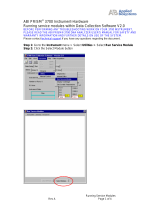4.1 Starting Sampling ...................................................................................................................................... 45
4.2 Background Spectrum............................................................................................................................... 45
5. Maintenance .......................................................................................................................... 47
5.1.1 Safety ...................................................................................................................................... 47
5.1.2 Precision Checks ........................................................................................................................ 47
5.1.3 H2O levels and Interpreting Strip.log ......................................................................................... 47
5.1.4 FTIR Spectrometer Alignment, Desiccant and Laser ................................................................. 48
5.1.5 Files ...................................................................................................................................... 48
5.1.6 Gas Cell ...................................................................................................................................... 48
5.1.7 Chemical Dryer Refill ................................................................................................................. 50
5.1.8 Particle Filter Element Replacement ......................................................................................... 52
5.1.9 Pump ...................................................................................................................................... 52
5.1.10 Leak Check ................................................................................................................................. 52
5.1.11 Sliding Out One of the Modules ................................................................................................ 54
5.1.12 Sliding Back in One of the Modules ........................................................................................... 55
5.1.13 Removing and Returning a Module from the Outer Case ......................................................... 56
5.1.14 Considerations when Working on Optical Module ................................................................... 61
5.1.15 Cell Isolation Valves ................................................................................................................... 61
5.1.16 Auxiliary Section Overview ........................................................................................................ 62
5.1.17 Checking & Adjusting the MFC Zero Pots .................................................................................. 62
5.1.18 OPUS Status Indicators .............................................................................................................. 64
5.1.19 Running the OPUS OVP ............................................................................................................. 65
5.1.20 OPUS - Abort Task ..................................................................................................................... 68
5.1.21 Cleaning ..................................................................................................................................... 68
5.1.22 Spare Parts List .......................................................................................................................... 68
6. Calibration .............................................................................................................................. 69
6.1 Calibration of FTIR Mole Fraction Measurements .................................................................................... 69
6.1.1 Quantitative Spectrum Analysis: MALT ..................................................................................... 69
6.1.2 Calibration Nomenclature ......................................................................................................... 69
6.1.3 Calibration Overview ................................................................................................................. 70
6.1.4 Spectrum Fitting ........................................................................................................................ 70
6.1.5 Calculation of Mole Fractions .................................................................................................... 70
6.1.6 Conversion to Dry Air Mole Fraction (DMF) .............................................................................. 70
6.1.7 Correction to Standard Conditions ............................................................................................ 71
6.1.8 Calibration to a Reference Scale ............................................................................................... 71
6.1.9 Isotopic Calculations and Calibration ........................................................................................ 72
6.1.10 Implementation of Calibration in Spectronus Software ............................................................ 75
6.1.11 Implementation of Calibration in Post-processing .................................................................... 75
6.1.12 Calibration Revision History ...................................................................................................... 75
6.2 Sensor Calibration ..................................................................................................................................... 75
6.3 Determining Cross Sensitivities ................................................................................................................ 76
6.3.1 Water Vapour & CO2 ................................................................................................................. 76
6.3.2 Pressure .................................................................................................................................... 78
6.3.3 Temperature ............................................................................................................................. 78
6.3.4 Typical Cross Sensitivity Coefficients ......................................................................................... 79
6.3.5 Stripping Water Vapour & CO2 Absorption Features from Background Spectra ....................... 79
6.3.6 Analysis of the Problem............................................................................................................. 79
6.3.7 Procedure Outline ..................................................................................................................... 80
6.3.8 Example ..................................................................................................................................... 80
























